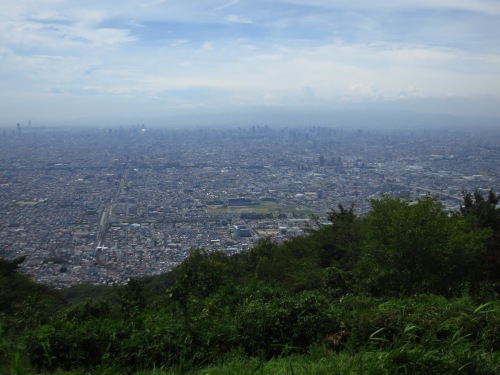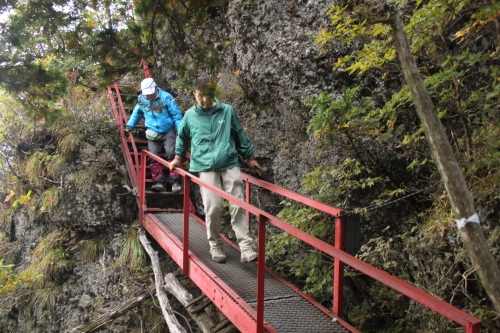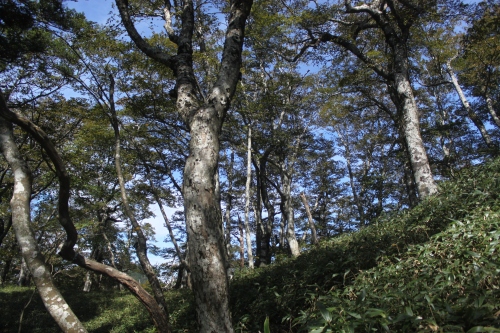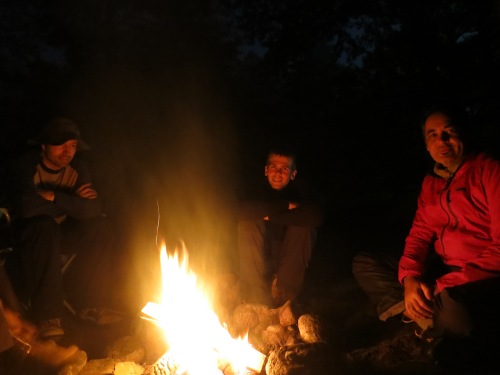6am. Not the greatest of departure times, but when Grace the Yamaholic comes calling, you drop what you’re doing and willfully oblige. Grace, Nao and I headed north on the highway, past the dense collection of skyscrapers of Osaka, around the dirty factories of Amagasaki, and north to the hinterlands of Sasayama, to explore the uppermost reaches of the Taki Alps, one of Kansai’s hidden treasures. Though only rising to a modest height of 700 meters, our two target peaks of the day held some challenging surprises.

Under a backdrop of subarctic winds and pre-dawn frost, we unloaded our gear at the mountain pass and prepared to face the first rays of the new day. It was 7:30am when we took our initial crunchy steps on peak #1, my earliest start in years. The route rose abruptly from the narrow saddle, a fresh coating of crystal powder covering the crisp leaves of a forgotten autumn. I took the lead, with Grace and Nao bringing up the rear. This allowed me to not only digitally capture the lonesome scenery of the barren woods , but also to offer a sense of scale by depicting my fellow climbers in a sleepy grimace as they struggle up the unforgiving contours of Mitake’s hallowed perch.

Mt. Mitake, the ‘honorific peak’, is common nomenclature for mountains holding religious significance, the greatest of which is the Shingon stalwart Ontake (御岳), which by no coincidence, utilizes the same characters of the Tokyo version of Mitake (御岳). Both mountains are covered with temples and shrines that attract both pilgrims and tourists alike. Kansai’s Mitake, on the other hand, has 4 different possible kanji readings: 御嶽、御岳、三岳、or 三嶽. Why there are so many readings for one mountain cannot be easily explained, but may be due to historical changes in the Japanese language, coupled together with the pen name preferred by the villagers living at the base of the peak. Even the trail designers seemed confused: the first sign at the pass indicates 御嶽 while further up the mountain you find 御岳 more prevalent, until reaching the summit, where you find both 御岳 and 三岳. The reality might be that no one truly knows the answer to this riddle, so for now this enigma will have to remain enigmatic.

The pitch of the route intensified. Steel links of chain draped from the craggy slabs like Rapunzel’s braided locks, leading us up to a broad saddle painted with smooth streaks of white. Our footsteps tell us that the snow must have fallen just hours if not minutes before our arrival. Subpolar gusts flowed from our right while ultraviolet rays forced their way westward, colliding in a vaporous swirl directly in our path. We were in the line of fire, so I quickened the pace until reaching a more sheltered area home to a shrine-enclosed grotto, where a centuries-old jizo statue peered out to check on our progress. A little further along we reached the high point of the peak which was christened with a cellular phone relay station. I’m sure the yamabushi would not be impressed.

After returning along the same trail back to the mountain pass, the three of us took refuge in a day shelter to refuel before starting towards our second target peak of Kogane. My watch read 8:45am. I’m usually just rousing myself out of bed around this time, but in the early hours I had already knocked off the highest point in the Taki Alps. A bear-warning sign welcomed us into Kogane’s cedar-heavy drainage, which we followed a short distance to the ridge, which retained its deciduous blanket of naked branches. The trail was easy to follow for the next few minutes until vanishing abruptly at the base of a family of sandstone bluffs. Looks like we had our work cut out for us.
I took the lead, forging a route through a notch in the rock before dropping just as steeply off the backside. This teeter-totter continued through a section of trail that was giving Mt. Myogi a run for its money. The views opened up back towards the gentle knob of Mitake before diving back into the trees for the final few steps towards the topmost pinnacle. We stopped a while to catch our breath while admiring the pleasant views and even more pleasant conversation.

Nao and I have both finished climbing the Hyakumeizan, so we had a lot of chat about. Grace, who was three-quarters of the way through her own pursuit, served as our mountain kōhai. It’s rare that you find yourself in the company of Hyakumeizan baggers, so the conversation naturally drifted to stories from our hikes spiced up with advice for the remaining peaks on Grace’s list.

Bone-piecing gales soon had us retesting back into the forest, which led us back to the thermal comforts of our automobile. On the way out, a stop to Sayasama’s Sunday temple market was in order. The village is one of the few untouched Edo-era castle towns left in Kansai. Spared the wrath of the Allied Forces air raids, the main street is like a step back to the dawn of the samurai era. Shops adorning the main street spread baskets of fresh produce all along their open facades: yardstick-sized green onions, Chinese cabbage that could double as bowling balls, and baseball bats disguised as daikon radishes fought for attention among the hefty bags of kuromame, a local fiber-packed delicacy. We entered a quaint noodle shop in search of warm soba noodles molded by the hands of time.

On the drive back to Osaka, our newly-formed trio spoke of future Kansai hikes into the hinterlands of Omine and the Kumano Kodo. We made it back in the early afternoon, giving me enough time to enjoy the rest of my day. Perhaps these early starts aren’t such a bad thing after all.





















